+ Open data
Open data
- Basic information
Basic information
| Entry | Database: PDB / ID: 6tvm | ||||||
|---|---|---|---|---|---|---|---|
| Title | LEDGF/p75 dimer (residues 345-467) | ||||||
 Components Components | PC4 and SFRS1-interacting protein | ||||||
 Keywords Keywords |  TRANSCRIPTION / epigenetic reader / integrase-binding domain / domain-swapped dimer TRANSCRIPTION / epigenetic reader / integrase-binding domain / domain-swapped dimer | ||||||
| Function / homology |  Function and homology information Function and homology information supercoiled DNA binding / Integration of viral DNA into host genomic DNA / Autointegration results in viral DNA circles / Formation of WDR5-containing histone-modifying complexes / 2-LTR circle formation / Vpr-mediated nuclear import of PICs / Integration of provirus / APOBEC3G mediated resistance to HIV-1 infection / mRNA 5'-splice site recognition / supercoiled DNA binding / Integration of viral DNA into host genomic DNA / Autointegration results in viral DNA circles / Formation of WDR5-containing histone-modifying complexes / 2-LTR circle formation / Vpr-mediated nuclear import of PICs / Integration of provirus / APOBEC3G mediated resistance to HIV-1 infection / mRNA 5'-splice site recognition /  heterochromatin ... heterochromatin ... supercoiled DNA binding / Integration of viral DNA into host genomic DNA / Autointegration results in viral DNA circles / Formation of WDR5-containing histone-modifying complexes / 2-LTR circle formation / Vpr-mediated nuclear import of PICs / Integration of provirus / APOBEC3G mediated resistance to HIV-1 infection / mRNA 5'-splice site recognition / supercoiled DNA binding / Integration of viral DNA into host genomic DNA / Autointegration results in viral DNA circles / Formation of WDR5-containing histone-modifying complexes / 2-LTR circle formation / Vpr-mediated nuclear import of PICs / Integration of provirus / APOBEC3G mediated resistance to HIV-1 infection / mRNA 5'-splice site recognition /  heterochromatin / nuclear periphery / heterochromatin / nuclear periphery /  euchromatin / response to heat / DNA-binding transcription factor binding / response to oxidative stress / euchromatin / response to heat / DNA-binding transcription factor binding / response to oxidative stress /  transcription coactivator activity / transcription coactivator activity /  chromatin remodeling / chromatin remodeling /  chromatin binding / positive regulation of transcription by RNA polymerase II / chromatin binding / positive regulation of transcription by RNA polymerase II /  RNA binding / RNA binding /  nucleoplasm / nucleoplasm /  nucleus / nucleus /  cytosol cytosolSimilarity search - Function | ||||||
| Biological species |   Homo sapiens (human) Homo sapiens (human) | ||||||
| Method |  SOLUTION NMR / torsion angle dynamics SOLUTION NMR / torsion angle dynamics | ||||||
 Authors Authors | Lux, V. / Veverka, V. | ||||||
 Citation Citation |  Journal: Structure / Year: 2020 Journal: Structure / Year: 2020Title: Molecular Mechanism of LEDGF/p75 Dimerization. Authors: Lux, V. / Brouns, T. / Cermakova, K. / Srb, P. / Fabry, M. / Madlikova, M. / Horejsi, M. / Kukacka, Z. / Novak, P. / Kugler, M. / Brynda, J. / DeRijck, J. / Christ, F. / Debyser, Z. / Veverka, V. | ||||||
| History |
|
- Structure visualization
Structure visualization
| Structure viewer | Molecule:  Molmil Molmil Jmol/JSmol Jmol/JSmol |
|---|
- Downloads & links
Downloads & links
- Download
Download
| PDBx/mmCIF format |  6tvm.cif.gz 6tvm.cif.gz | 2.7 MB | Display |  PDBx/mmCIF format PDBx/mmCIF format |
|---|---|---|---|---|
| PDB format |  pdb6tvm.ent.gz pdb6tvm.ent.gz | 2.3 MB | Display |  PDB format PDB format |
| PDBx/mmJSON format |  6tvm.json.gz 6tvm.json.gz | Tree view |  PDBx/mmJSON format PDBx/mmJSON format | |
| Others |  Other downloads Other downloads |
-Validation report
| Arichive directory |  https://data.pdbj.org/pub/pdb/validation_reports/tv/6tvm https://data.pdbj.org/pub/pdb/validation_reports/tv/6tvm ftp://data.pdbj.org/pub/pdb/validation_reports/tv/6tvm ftp://data.pdbj.org/pub/pdb/validation_reports/tv/6tvm | HTTPS FTP |
|---|
-Related structure data
| Similar structure data | |
|---|---|
| Other databases |
|
- Links
Links
- Assembly
Assembly
| Deposited unit | 
| |||||||||
|---|---|---|---|---|---|---|---|---|---|---|
| 1 |
| |||||||||
| NMR ensembles |
|
- Components
Components
| #1: Protein | Mass: 14644.854 Da / Num. of mol.: 2 Source method: isolated from a genetically manipulated source Source: (gene. exp.)   Homo sapiens (human) / Gene: PSIP1, DFS70, LEDGF, PSIP2 / Production host: Homo sapiens (human) / Gene: PSIP1, DFS70, LEDGF, PSIP2 / Production host:   Escherichia coli (E. coli) / References: UniProt: O75475 Escherichia coli (E. coli) / References: UniProt: O75475 |
|---|
-Experimental details
-Experiment
| Experiment | Method:  SOLUTION NMR SOLUTION NMR | ||||||||||||||||||||||||||||||||||||||||||||||||||||||
|---|---|---|---|---|---|---|---|---|---|---|---|---|---|---|---|---|---|---|---|---|---|---|---|---|---|---|---|---|---|---|---|---|---|---|---|---|---|---|---|---|---|---|---|---|---|---|---|---|---|---|---|---|---|---|---|
| NMR experiment |
|
- Sample preparation
Sample preparation
| Details | Type: solution Contents: 0.5 mM [U-13C; U-15N] LEDGF, 20 mM HEPES, 100 mM sodium chloride, 1 mM TCEP, 95% H2O/5% D2O Label: cn / Solvent system: 95% H2O/5% D2O | ||||||||||||||||||||
|---|---|---|---|---|---|---|---|---|---|---|---|---|---|---|---|---|---|---|---|---|---|
| Sample |
| ||||||||||||||||||||
| Sample conditions | Ionic strength: 120 mM / Label: cn1 / pH: 7 / Pressure: 1 atm / Temperature: 298 K |
-NMR measurement
| NMR spectrometer | Type: Bruker AVANCE / Manufacturer: Bruker / Model : AVANCE / Field strength: 850 MHz : AVANCE / Field strength: 850 MHz |
|---|
- Processing
Processing
| NMR software |
| |||||||||||||||
|---|---|---|---|---|---|---|---|---|---|---|---|---|---|---|---|---|
| Refinement | Method: torsion angle dynamics / Software ordinal: 1 | |||||||||||||||
| NMR representative | Selection criteria: lowest energy | |||||||||||||||
| NMR ensemble | Conformer selection criteria: structures with the least restraint violations Conformers calculated total number: 100 / Conformers submitted total number: 30 |
 Movie
Movie Controller
Controller



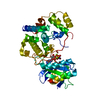
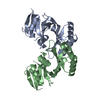
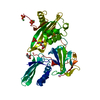
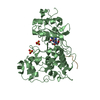
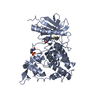
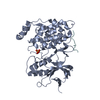
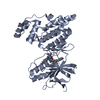
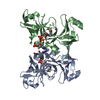
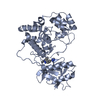
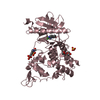
 PDBj
PDBj





